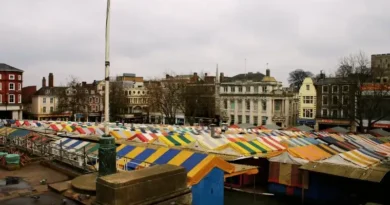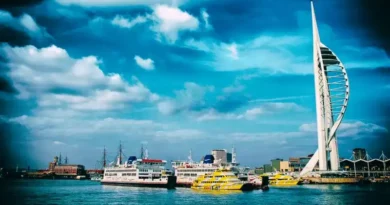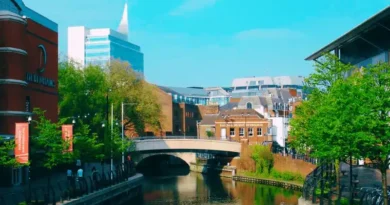Get to Windsor Castle From Plymouth
Key Points
- Windsor Castle is approximately 218 miles (351 km) from Plymouth, with a driving time of around 3 hours and 37 minutes via the M5 and M4 motorways under ideal conditions.
- The fastest and most convenient way to travel from Plymouth to Windsor Castle is by car via the M5 and M4 motorways, covering 218 miles in approximately 3 hours and 36 minutes. This direct route offers smooth travel with service stations along the way for rest stops.
- An alternative by car is via the A303, covering 196 miles in around 3 hours and 37 minutes. Though slightly shorter in distance, it can experience delays near Stonehenge.
- By train, the fastest route takes 4 hours and 33 minutes, involving a replacement bus from Plymouth to Tiverton Parkway, then a Great Western Railway train to London Paddington, followed by the Elizabeth Line to Slough, and finally a train to Windsor & Eton Central.
- Alternative train routes include travelling via Exeter or Bristol, though these may take up to 5 hours and 14 minutes depending on changes and waiting times.
- For cycling, two main routes via National Cycle Routes 2 or 3 covers over 230 miles, requiring at least 20-22 hours of cycling over multiple days, with varied terrain and significant elevation gains.
- Overall, driving via M5/M4 is the best option for speed and convenience, while taking the train is the best public transport option for those without a car. Cycling is viable but demands considerable endurance and planning.
Getting to Windsor Castle From Plymouth by Car
Routes Comparison
| Feature | Route 1: M5 & M4 | Route 2: A38, M5 & M4 | Route 3: A303 |
|---|---|---|---|
| Distance (miles) | 218 | 217 | 196 |
| Estimated Time | 3h 37m | 3h 36m | 3h 37m |
| Main Roads Used | M5, M4 | A38, M5, M4 | A38, A30, A303, M3 |
| Scenic Route | No | No | Yes |
| Traffic Concerns | Possible congestion on M4 | Possible congestion on M4 | Heavy traffic near Stonehenge |
| Toll Roads | Yes (M4) | Yes (M4) | No |
| Rest Stops | Service stations along M5, M4 | Service stations along M5, M4 | Services along A303, M3 |
| Potential Closures | Sheet Street/B3022 in Windsor | Sheet Street/B3022 in Windsor | Sheet Street/B3022 in Windsor |
| Best for | Fastest and most direct route | Similar to Route 1 but a slight variation in departure roads | Scenic drive with countryside views |
Route 1: Via M5 and M4
Travelling from Plymouth to Windsor Castle by car is a relatively straightforward journey, taking approximately 3 hours and 37 minutes under ideal conditions. Covering a distance of 218 miles, the most efficient route follows the M5 and M4 motorways, ensuring a smooth and direct trip. Below is a step-by-step guide to reaching Windsor Castle, including necessary precautions and useful tools for the journey.
1. Departing from Plymouth
Begin your journey from Plymouth, United Kingdom, and head towards the A38 (Devon Expressway).
- Start at North Cross Roundabout and move east towards North Road East (348 ft).
- Exit onto Cobourg Street/A374 and continue on A374 for 0.4 miles.
- Take the 2nd exit onto Exeter Street/A374 (0.5 miles) at Charles Cross Roundabout.
- At Cattedown Roundabout, take the 4th exit onto Shapters Road/A374, heading towards A38 (0.8 miles).
- Continue straight onto Embankment Road/A374 and follow it for 1.8 miles.
- At the roundabout, take the 3rd exit onto the A38 ramp towards Exeter/Paignton/A385 (0.6 miles).
- Merge onto the Devon Expressway/A38 and continue for 36.7 miles.
2. Following the M5 and M4 Motorways
- Keep right to continue on the M5 motorway, following signs for Taunton, Honiton, and Barnstaple (80.8 miles).
- Use the left three lanes to take the M4 (West) exit towards South Wales, Chepstow, M48, and London (1.2 miles).
- Merge onto the M4 and continue driving for 91.8 miles.
- Take the exit towards A355 in Slough (0.3 miles).
3. Final Approach to Windsor Castle
- At the roundabout, take the 3rd exit onto A355 (0.5 miles).
- Continue onto Royal Windsor Way/A332 (1.2 miles).
- Slight left onto Clarence Road and pass through one roundabout (0.5 miles).
- Continue onto Victoria Street (0.3 miles).
- Take the 1st exit onto Sheet Street/B3022 at the roundabout and continue (0.2 miles).
- Turn right onto Castle Hill (266 ft), and you will arrive at Windsor Castle.
Important Considerations
- Potential Road Closures: Some roads near Windsor Castle (e.g., Sheet Street/B3022) may be closed at certain times or days.
- Toll Roads: The M4 motorway includes some toll sections; ensure you have suitable payment methods available.
- Rest Stops: Plan breaks at service stations along the M5 and M4 for refreshments and refuelling.
- Fuel Stations: Ensure your vehicle has enough fuel before embarking on the journey, and note fuel stops along the route.
Following these detailed steps and taking necessary precautions, your journey from Plymouth to Windsor Castle should be a smooth and enjoyable experience.
Route 2: Via Devon Expressway (A38), M5, and M4

Travelling from Plymouth to Windsor Castle by car covers a distance of approximately 217 miles and takes around 3 hours and 36 minutes under ideal conditions. This route primarily follows major motorways, ensuring a relatively straightforward and efficient journey.
1. Departing Plymouth
Begin your journey in Plymouth by heading east on North Cross Roundabout toward North Road East.
- Exit the roundabout onto North Road East (315 ft).
- Turn right to stay on North Road East (0.3 mi).
- Turn left onto North Hill/B3250 (0.2 mi).
- Continue onto Alexandra Road/B3214 (1.5 mi).
- Take the 1st exit onto Old Laira Road/B3214 (482 ft) at the roundabout.
- Merge onto Plymouth Road/A374 (0.7 mi).
- Take the 3rd exit onto the A38 ramp at the roundabout to Exeter/Paignton/A385 (0.6 mi).
- Merge onto Devon Expressway/A38 (36.7 mi), continuing towards Exeter.
2. Following M5 and M4 to Slough
Upon reaching the junction with the M5, continue northbound.
- Keep right to continue on M5, following signs for Taunton, Honiton, and Barnstaple (80.8 mi).
- Use the left three lanes to take the M4(W) exit toward South Wales, Chepstow, M48, and London (1.2 mi).
- Merge onto the M4 (91.8 mi), travelling east toward London.
- Take the exit toward A355 (0.3 mi), leading towards Slough.
3. Final Approach to Windsor Castle
As you leave the M4, follow local roads toward Windsor Castle.
- At the roundabout, take the 3rd exit onto A355 (0.5 mi).
- Continue onto Royal Windsor Way/A332 (1.2 mi).
- Slight left onto Clarence Road (0.5 mi), passing through one roundabout.
- Continue onto Victoria Street (0.3 mi).
- At the roundabout, take the 1st exit onto Sheet Street/B3022 (0.2 mi).
- Parts of this road may be closed at certain times or on specific days.
- Turn right onto Castle Hill (266 ft).
You have now arrived at Windsor Castle, a historic royal residence and a popular tourist attraction in the United Kingdom.
Route 3: A303

If you’re travelling from Plymouth to Windsor Castle by car, taking the A303 route is convenient. This journey covers approximately 196 miles and takes around 3 hours and 37 minutes under ideal traffic conditions. Below is a detailed step-by-step guide to help you navigate the route efficiently.
Step 1: Departing Plymouth
- Begin at North Cross Roundabout, heading east towards North Road East (348 ft).
- Exit the roundabout onto Cobourg Street/A374, continuing on A374 (0.4 mi).
- Take the 2nd exit onto Exeter Street/A374 (0.5 mi) at Charles Cross Roundabout.
- At Cattedown Roundabout, take the 4th exit onto Shapters Road/A374, following signs for A38 (0.8 mi).
- Continue on Embankment Road/A374 (1.8 mi).
- At the roundabout, take the 3rd exit onto the A38 ramp towards Exeter/Paignton/A385 (0.6 mi).
Step 2: Plymouth to Winkfield Row
- Merge onto Devon Expressway/A38 (36.7 mi).
- Keep right to continue on M5, following signs for Taunton/Honiton/Barnstaple (4.7 mi).
- At junction 29, take the A30 exit towards Honiton/Exeter Airport (0.5 mi).
- Use any lane to turn left onto A30 (19.3 mi).
- Continue onto A303 (10.1 mi).
- At Southfields Roundabout, take the 3rd exit onto Ilminster Bypass/A303 (6.4 mi).
- Take the 2nd exit onto A303 (3.2 mi) at Hayes End Roundabout.
- At Cartgate Roundabout, take the 2nd exit to stay on A303 (5.3 mi).
- At Podimore Roundabout, take the 3rd exit and stay on A303 (38.4 mi).
- At Longbarrow Roundabout, take the 2nd exit and stay on A303 (3.4 mi).
- At Countess Roundabout, take the 2nd exit onto Amesbury Bypass/A303 (28.0 mi).
- Use the right lane to take the M3 ramp (24.3 mi).
- At junction 3, use the left 2 lanes to take the A322 exit to Woking/Bracknell (0.2 mi).
- At the roundabout, take the 1st exit onto A322 (1.7 mi).
- Keep right to continue on Bracknell Road/A322 (0.1 mi).
Step 3: Winkfield Row to Windsor Castle
- At the roundabout, take the 2nd exit onto Swinley Road/A332 (2.7 mi).
- At the roundabout, take the 2nd exit onto Kings Ride/A332 (0.1 mi).
- At the roundabout, take the 2nd exit onto Windsor Road/A332 (2.3 mi).
- At the roundabout, take the 4th exit onto A332 (3.3 mi).
- At the roundabout, take the 3rd exit onto Kings Road (0.5 mi).
- Continue onto Sheet Street/B3022 (0.3 mi) (Note: Parts of this road may be closed at certain times or days).
- Turn right onto Castle Hill (266 ft).
Destination: Windsor Castle
You have arrived at Windsor Castle, a historic royal residence and one of the most famous landmarks in the United Kingdom.
Important Tips & Cautions
- Traffic Conditions: The A303 is a popular route and can experience congestion, particularly near Stonehenge.
- Speed Limits: Consider variable speed limits along the M3 and other major roads.
- Road Closures: Some parts of Sheet Street/B3022 may be closed at certain times—check local road updates before travelling.
- Rest Stops: Consider stopping at service stations along M5, A303, or M3 for breaks and refreshments.
This route offers a scenic and efficient journey from Plymouth to Windsor Castle, balancing motorways with picturesque countryside roads. Safe travels!
Getting to Windsor Castle From Plymouth by Train
Travelling from Plymouth to Windsor Castle by train involves multiple routes with varying travel times, stops, and transfer points. The journey can take anywhere from approximately 4 hours and 33 minutes to around 5 hours and 14 minutes, depending on the specific route chosen. The differences in travel duration are influenced by factors such as the number of transfers, waiting times between connections, and the choice of transport modes.
Fastest Route: 4 Hours 33 Minutes
One of the faster options, taking around 4 hours and 33 minutes, involves a combination of a replacement bus, trains, and a short walk. The journey begins with a replacement bus from Plymouth to Tiverton Parkway, which takes approximately 1 hour and 20 minutes without stops. Upon arrival at Tiverton Parkway, passengers walk a short distance to board a train to London Paddington, a trip lasting about 1 hour and 30 minutes with two stops along the way.
From Reading, a 22-minute train ride via the Elizabeth Line leads to Slough, where passengers transfer onto another train to Windsor & Eton Central. The final stretch is a short 7-minute walk to Windsor Castle. This route benefits from relatively short waiting times between transfers, contributing to its overall efficiency.
Alternative Route: 4 Hours 53 Minutes
A slightly longer route, taking around 4 hours and 53 minutes, starts with a National Express coach from Plymouth to Exeter, lasting approximately 1 hour and 10 minutes. This is followed by a short walk and a local bus ride to Exeter St Davids, where passengers board a CrossCountry train bound for Bristol Parkway, a journey lasting approximately 1 hour and 15 minutes with four stops. From Bristol Parkway, a Great Western Railway (GWR) train to London Paddington takes 50 minutes, with two stops en route.
At Reading, passengers switch to the Elizabeth Line for a 22-minute journey to Slough, followed by a 6-minute train ride to Windsor & Eton Central. A final short walk completes the journey. The additional transfers and slightly longer wait times increase travel duration.
Longest Route: 5 Hours 14 Minutes
Another alternative takes approximately 5 hours and 14 minutes. This route is similar to the first but involves a different train connection at Reading. Instead of the Elizabeth Line, passengers board a South Western Railway train to London Waterloo, which takes 49 minutes and includes 12 stops.
At Staines, they change trains for a 14-minute journey to Windsor & Eton Riverside, followed by a 10-minute walk to Windsor Castle. The higher number of stops and longer connection times in this route contribute to its extended duration.
Factors Affecting Travel Time
The variation in travel times across these routes can be attributed to several factors. Different modes of transport, such as replacement buses, express coaches, and trains operated by different rail companies, affect the overall journey duration.
Additionally, the frequent stops on certain rail services influence how quickly one can reach key transfer points. Routes utilising the Elizabeth Line tend to be quicker due to fewer stops and efficient connections, while those incorporating South Western Railway services require more transfers and additional waiting times.
Choosing the Best Route
Ultimately, the fastest journeys are those with the least number of transfers and minimal waiting times between connections. When selecting their route, travellers should consider their preferred balance between speed and convenience. Those prioritising shorter travel times may opt for routes with fewer changes, while others might prefer slightly longer routes offering more connection flexibility.
Planning ahead and checking live schedules can help ensure the most efficient journey from Plymouth to Windsor Castle.
Cycling from Plymouth to Windsor Castle
Embarking on a cross-country cycling journey from Plymouth to Windsor Castle presents a significant physical and navigational challenge. The provided data outlines two distinct routes, each with its own set of demands and characteristics. This analysis aims to dissect these routes, highlighting key factors for prospective cyclists.
Distance and Duration
Both routes, one via National Cycle Route 3 and the other via National Cycle Route 2, exceed 230 miles. The estimated cycling times, ranging from 20 to 22 hours, indicate a journey demanding sustained effort over multiple days for most cyclists. Realistically, factoring in rest stops, meal breaks, and potential delays, this trip could easily extend to three or four days or even longer.
The sheer distance necessitates meticulous planning, including accommodation arrangements and a realistic assessment of personal fitness levels.
Elevation Profile
The elevation profiles of both routes reveal considerable vertical gain and loss. The National Cycle Route 3 option presents a cumulative ascent and descent of approximately 6,200 feet, while the National Cycle Route 2 alternative exhibits a more challenging profile with over 9,400 feet of climbing.
This substantial elevation change translates to numerous climbs and descents, requiring cyclists to possess strong leg muscles and effective gear management. The varied terrain will likely include steep inclines and potentially lengthy descents, demanding both physical exertion and careful bike handling.
Navigational Complexity
The detailed turn-by-turn directions highlight the intricate nature of the routes. Numerous junctions, roundabouts, and changes in road type contribute to the navigational complexity. Cyclists must rely heavily on GPS devices or detailed maps and be prepared to check their progress frequently. The presence of numerous National Cycle Routes, with their own signposting, adds another layer of complexity. Careful observation and a keen sense of direction are essential to avoid getting lost.
Restricted Access and Private Roads: Potential Detours
A significant concern highlighted in the data is the presence of restricted usage or private roads along both routes. This necessitates a degree of flexibility and preparedness for potential detours. Cyclists should be aware that they may encounter sections where they are required to dismount and walk their bikes or where they need to find alternative routes.
Pre-planning potential detours and carrying detailed maps is crucial to mitigate the impact of these restrictions.
Urban and Rural Transitions
The routes traverse diverse environments, from busy urban streets to quiet rural lanes. Cyclists will experience the challenges of navigating through towns and cities, dealing with traffic and pedestrian congestion, and the relative tranquillity of cycling through countryside areas. This transition between urban and rural settings will require cyclists to adapt their riding style and be aware of changing road conditions.
National Cycle Routes
Both routes heavily utilise the National Cycle Network, a system of signed cycle routes across the UK. This network provides dedicated or shared-use paths to offer safer and more enjoyable cycling experiences. However, the quality and consistency of these routes can vary. Cyclists should be prepared for sections of rough terrain, narrow paths, or shared-use routes with pedestrians and other users.
Safety Considerations
Given the length and complexity of the journey, safety should be a paramount concern. Cyclists should ensure their bikes are in good working order, carry essential repair tools, and wear appropriate safety gear, including helmets and high-visibility clothing. They should also be prepared for varying weather conditions, carrying waterproof clothing and adequate hydration.
Planning daily mileage and rest stops is also important to prevent fatigue and potential accidents.
Conclusion
Travelling from Plymouth to Windsor Castle offers multiple options, each catering to different preferences and priorities. Driving via the M5 and M4 is the fastest and most convenient choice, while the A303 provides a slightly shorter but potentially slower alternative. For those relying on public transport, train journeys vary in duration, with the fastest taking just over four and a half hours. Cycling is an option for the adventurous but requires extensive preparation.
Ultimately, the best route depends on individual needs, balancing time, comfort, and personal travel preferences.









